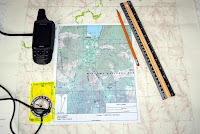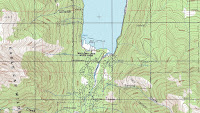Sighting with a compass is an important skill that can determine direction to an object or help the hiker locate and identify his position in the backcountry.
A compass is an important part of the backcountry navigator’s kit. The use of Global
Positioning System (GPS) receivers has simplified navigation to an extent but the knowledge of how to use a compass is still important; do not underestimate this skill.
Positioning System (GPS) receivers has simplified navigation to an extent but the knowledge of how to use a compass is still important; do not underestimate this skill.
“A compass is basically a magnet mounted on a pivot, free to turn in response to the pull of the earth’s magnetic field. The housing protects the needle and helps you relate the direction in which the needle points to directions on the map and on the land. A compass by itself can’t tell you where you are or what you are looking at but it can tell you about direction….”
Staying Found, The Complete Map & Compass Handbook, by June Fleming
Sighting with a compass allows the hiker to determine the direction to an object such as a mountain peak. The compass direction to an object is known as the “bearing” or azimuth. Bearing is the more common term in outdoor recreation and is a term used heavily in GPS navigation. For example, if a mountain peak is due north of you, the bearing to the peak is 000° (read as zero zero zero degrees.)
Sighting with a compass allows the hiker to do several things. First, sighting on a distant object can provide direction to that object and repeated sightings can provide course corrections along the way. Secondly, with several sightings on different objects a person’s position can be triangulated.
This article will focus on using a standard baseplate compass such as the two examples pictured below. (The lensatic and military compass will not be discussed.)
Figure 1 Two examples of good baseplate compasses.
Key features of the two compasses (above) include:
- They are declination adjustable
- Liquid filled housing to dampen the magnetic needle’s movement
- 2° increments on the bearing dial of the compass housing
- A clear baseplate of adequate size with map scale information and a small magnifier.
The picture below offers a quick review of the components of a baseplate compass.
To sight or take a bearing do the following:
- Using the owner’s manual, adjust the compass for declination.
- While holding the compass at waist level, turn squarely towards a distant object. Hold the compass so that the direction of travel arrow points directly at the object. (Point the direction of travel arrow away from you; perpendicular to your body.)
- While holding the compass, turn the compass housing (the dial) and align the orienting arrow (engraved in the rotating housing) underneath the red magnetic needle.
- In this example, the compass has been adjusted to a bearing of 011° degrees. The bearing data is found where the direction of travel arrow intersects the compass housing.
At this point the hiker can walk towards the object (e.g., mountain peak, or abuilding) on a bearing of 011°.
If the hiker needs to determine his position, the next step is to triangulate using three bearings. In a “nut shell” this means that bearings to three clearly identifiable features are used. Ideally, objects that have a bearing separation of 30° – 60° will be used. Good bearing separation provides better fixing information and plots on the map cleanly. The bearings are then plotted on a map and where the three lines cross is the hiker’s location. This complete process is called triangulation.
The following are suggestions for triangulating a position in the back country.
- Identify three distinct objects to sight on. Note that the objects need to be on the topographic map (topo) of the area. I recommend carrying a forest service map (or something similar) of the area in addition to the topo just incase the objects are too far away.
- Orient the topo using the compass. Orienting the topo means that the map’s left or right border is pointing to true north or 000° degrees true. See “Orienting a Map” for more information.
- Sight on an object such as a mountain peak or church spire. (Note that not many objects in the backcountry are so distinct and crisp. Do the best with what you have.) Ensure the direction of travel arrow is pointed towards the object.
- As discussed earlier, turn the compass housing until the orienting arrow is directly under red magnetic needle. Do not move or rotate the compass housing, keep the new bearing in place.
- At this point, and while plotting the bearing on the map, the compass will now be used like a protractor.
- Lay the compass on the map with either the top left or right corner of the baseplate on the landmark. This will be a pivot point while aligning the compass.
- With the edge of the baseplate in position, rotate the compass (swing) left or right until the N (north) of the compass housing aligns with map North (the top of the map.) What is even better, with the map oriented to north, as the baseplate is rotated, the red magnetic needle will swing back into position on top of the orienting arrow.
- Draw a line (along the baseplate) from the object to your approximate area.
- Repeat the process two more times.



























